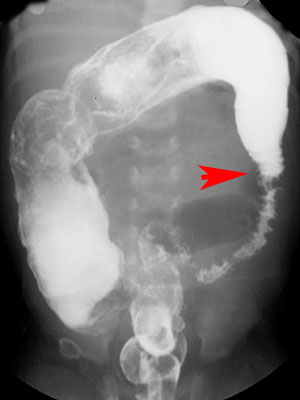GI Radiology > Colon > Congenital Anomalies
Congenital Anomalies
![]()
IntroductionCongenital diseases are most commonly encountered in the Pediatric population. This site will describe a few of the more common ones. Please also see the Pediatric Radiology tutorial. |
|
Hirschsprung's Disease |
|
|
Hirschsprung's Disease (AKA congenital aganglionic megacolon) is a congenital disease that occurs in 1 in every 5000 births and is more common in boys. It is caused by the failure of neural crest cells to migrate to the wall of the colon and/or rectum during fetal development. Since these nerve cells are normally responsible for bowel peristalsis, their absence causes constipation and obstruction. The rectosigmoid is involved in 75-80% of cases. In infants the primary sign is absence of meconium within the first 24-48 hours of life. A fraction of patients may alternatively develop chronic constipation later in the first month of life. In either presentation an intestinal obstruction occurs, which may lead to abdominal distention, vomiting, poor feeding, and poor weight gain. In rare cases, symptoms do not develop until late childhood, in which case the patient would exhibit lack of appetite and the passing small watery stools. Abdominal plain films will show gaseous distention of the intestines and an absence of gas and stool in the rectum.
Barium enema demonstrates a transition zone (an area between the normal colon and the constricted area that is affected by the lack of ganglion cells). Rectal biopsies are diagnostic and would show a lack of ganglion cells. Treatment is with surgical repair: series of operations known as pullthrough procedures (Swenson, Duhamel, Soave). First the abnormal segment of bowel is resected, a colostomy is created, and finally the healthy bowel is connected to the anus just superior to the sphincter.
Barium enema with transition zone (arrow) |

